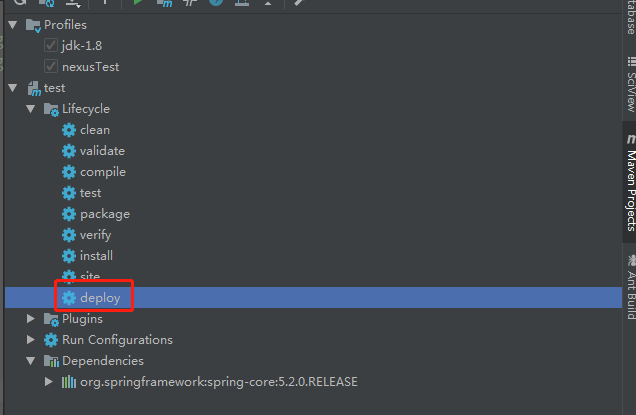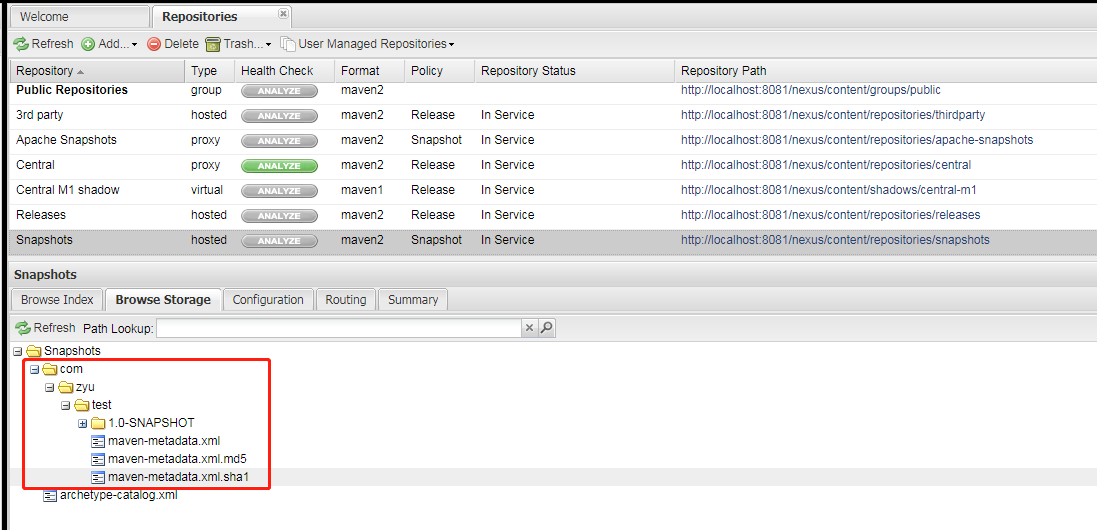Nexus 上传项目到私服

1. maven setting配置
<?xml version="1.0" encoding="UTF-8"?> <!--
Licensed to the Apache Software Foundation (ASF) under one
or more contributor license agreements. See the NOTICE file
distributed with this work for additional information
regarding copyright ownership. The ASF licenses this file
to you under the Apache License, Version 2.0 (the
"License"); you may not use this file except in compliance
with the License. You may obtain a copy of the License at http://www.apache.org/licenses/LICENSE-2.0 Unless required by applicable law or agreed to in writing,
software distributed under the License is distributed on an
"AS IS" BASIS, WITHOUT WARRANTIES OR CONDITIONS OF ANY
KIND, either express or implied. See the License for the
specific language governing permissions and limitations
under the License.
--> <!--
| This is the configuration file for Maven. It can be specified at two levels:
|
| 1. User Level. This settings.xml file provides configuration for a single user,
| and is normally provided in ${user.home}/.m2/settings.xml.
|
| NOTE: This location can be overridden with the CLI option:
|
| -s /path/to/user/settings.xml
|
| 2. Global Level. This settings.xml file provides configuration for all Maven
| users on a machine (assuming they're all using the same Maven
| installation). It's normally provided in
| ${maven.conf}/settings.xml.
|
| NOTE: This location can be overridden with the CLI option:
|
| -gs /path/to/global/settings.xml
|
| The sections in this sample file are intended to give you a running start at
| getting the most out of your Maven installation. Where appropriate, the default
| values (values used when the setting is not specified) are provided.
|
|-->
<settings xmlns="http://maven.apache.org/SETTINGS/1.0.0"
xmlns:xsi="http://www.w3.org/2001/XMLSchema-instance"
xsi:schemaLocation="http://maven.apache.org/SETTINGS/1.0.0 http://maven.apache.org/xsd/settings-1.0.0.xsd">
<!-- localRepository
| The path to the local repository maven will use to store artifacts.
|
| Default: ${user.home}/.m2/repository -->
<localRepository>E:\DevelopEnvironment\Maven\repository</localRepository>
<!-- interactiveMode
| This will determine whether maven prompts you when it needs input. If set to false,
| maven will use a sensible default value, perhaps based on some other setting, for
| the parameter in question.
|
| Default: true
<interactiveMode>true</interactiveMode>
--> <!-- offline
| Determines whether maven should attempt to connect to the network when executing a build.
| This will have an effect on artifact downloads, artifact deployment, and others.
|
| Default: false
<offline>false</offline>
--> <!-- pluginGroups
| This is a list of additional group identifiers that will be searched when resolving plugins by their prefix, i.e.
| when invoking a command line like "mvn prefix:goal". Maven will automatically add the group identifiers
| "org.apache.maven.plugins" and "org.codehaus.mojo" if these are not already contained in the list.
|-->
<pluginGroups>
<!-- pluginGroup
| Specifies a further group identifier to use for plugin lookup.
<pluginGroup>com.your.plugins</pluginGroup>
-->
</pluginGroups> <!-- proxies
| This is a list of proxies which can be used on this machine to connect to the network.
| Unless otherwise specified (by system property or command-line switch), the first proxy
| specification in this list marked as active will be used.
|-->
<proxies>
<!-- proxy
| Specification for one proxy, to be used in connecting to the network.
|
<proxy>
<id>optional</id>
<active>true</active>
<protocol>http</protocol>
<username>proxyuser</username>
<password>proxypass</password>
<host>proxy.host.net</host>
<port>80</port>
<nonProxyHosts>local.net|some.host.com</nonProxyHosts>
</proxy>
-->
</proxies> <!-- servers
| This is a list of authentication profiles, keyed by the server-id used within the system.
| Authentication profiles can be used whenever maven must make a connection to a remote server.
|-->
<servers>
<!-- server
| Specifies the authentication information to use when connecting to a particular server, identified by
| a unique name within the system (referred to by the 'id' attribute below).
|
| NOTE: You should either specify username/password OR privateKey/passphrase, since these pairings are
| used together.
|
<server>
<id>deploymentRepo</id>
<username>repouser</username>
<password>repopwd</password>
</server>
--> <!-- Another sample, using keys to authenticate.
<server>
<id>siteServer</id>
<privateKey>/path/to/private/key</privateKey>
<passphrase>optional; leave empty if not used.</passphrase>
</server>
-->
<server>
<id>releases</id>
<username>admin</username>
<password>admin123</password>
</server>
<server>
<id>snapshots</id>
<username>admin</username>
<password>admin123</password>
</server>
</servers> <!-- mirrors
| This is a list of mirrors to be used in downloading artifacts from remote repositories.
|
| It works like this: a POM may declare a repository to use in resolving certain artifacts.
| However, this repository may have problems with heavy traffic at times, so people have mirrored
| it to several places.
|
| That repository definition will have a unique id, so we can create a mirror reference for that
| repository, to be used as an alternate download site. The mirror site will be the preferred
| server for that repository.
|-->
<mirrors>
<!-- mirror
| Specifies a repository mirror site to use instead of a given repository. The repository that
| this mirror serves has an ID that matches the mirrorOf element of this mirror. IDs are used
| for inheritance and direct lookup purposes, and must be unique across the set of mirrors.
|
<mirror>
<id>mirrorId</id>
<mirrorOf>repositoryId</mirrorOf>
<name>Human Readable Name for this Mirror.</name>
<url>http://my.repository.com/repo/path</url>
</mirror>
-->
<mirror>
<id>nexus-releases</id>
<mirrorOf>*</mirrorOf>
<url>http://localhost:8081/nexus/content/groups/public</url>
</mirror>
<mirror>
<id>nexus-snapshots</id>
<mirrorOf>*</mirrorOf>
<url>http://localhost:8081/nexus/content/repositories/snapshots/</url>
</mirror>
</mirrors> <!-- profiles
| This is a list of profiles which can be activated in a variety of ways, and which can modify
| the build process. Profiles provided in the settings.xml are intended to provide local machine-
| specific paths and repository locations which allow the build to work in the local environment.
|
| For example, if you have an integration testing plugin - like cactus - that needs to know where
| your Tomcat instance is installed, you can provide a variable here such that the variable is
| dereferenced during the build process to configure the cactus plugin.
|
| As noted above, profiles can be activated in a variety of ways. One way - the activeProfiles
| section of this document (settings.xml) - will be discussed later. Another way essentially
| relies on the detection of a system property, either matching a particular value for the property,
| or merely testing its existence. Profiles can also be activated by JDK version prefix, where a
| value of '1.4' might activate a profile when the build is executed on a JDK version of '1.4.2_07'.
| Finally, the list of active profiles can be specified directly from the command line.
|
| NOTE: For profiles defined in the settings.xml, you are restricted to specifying only artifact
| repositories, plugin repositories, and free-form properties to be used as configuration
| variables for plugins in the POM.
|
|-->
<profiles>
<!-- profile
| Specifies a set of introductions to the build process, to be activated using one or more of the
| mechanisms described above. For inheritance purposes, and to activate profiles via <activatedProfiles/>
| or the command line, profiles have to have an ID that is unique.
|
| An encouraged best practice for profile identification is to use a consistent naming convention
| for profiles, such as 'env-dev', 'env-test', 'env-production', 'user-jdcasey', 'user-brett', etc.
| This will make it more intuitive to understand what the set of introduced profiles is attempting
| to accomplish, particularly when you only have a list of profile id's for debug.
|
| This profile example uses the JDK version to trigger activation, and provides a JDK-specific repo.
<profile>
<id>jdk-1.4</id> <activation>
<jdk>1.4</jdk>
</activation> <repositories>
<repository>
<id>jdk14</id>
<name>Repository for JDK 1.4 builds</name>
<url>http://www.myhost.com/maven/jdk14</url>
<layout>default</layout>
<snapshotPolicy>always</snapshotPolicy>
</repository>
</repositories>
</profile>
-->
<profile>
<id>jdk-1.8</id>
<activation>
<activeByDefault>true</activeByDefault>
<jdk>1.8</jdk>
</activation>
<properties>
<maven.compiler.source>1.8</maven.compiler.source>
<maven.compiler.target>1.8</maven.compiler.target>
<maven.compiler.compilerVersion>1.8</maven.compiler.compilerVersion>
</properties>
</profile>
<profile>
<id>nexusTest</id>
<repositories>
<repository>
<id>local-nexus</id>
<url>http://localhost:8081/nexus/content/groups/public/</url>
<releases>
<enabled>true</enabled>
</releases>
<snapshots>
<enabled>true</enabled>
</snapshots>
</repository>
</repositories>
</profile> <!--
| Here is another profile, activated by the system property 'target-env' with a value of 'dev',
| which provides a specific path to the Tomcat instance. To use this, your plugin configuration
| might hypothetically look like:
|
| ...
| <plugin>
| <groupId>org.myco.myplugins</groupId>
| <artifactId>myplugin</artifactId>
|
| <configuration>
| <tomcatLocation>${tomcatPath}</tomcatLocation>
| </configuration>
| </plugin>
| ...
|
| NOTE: If you just wanted to inject this configuration whenever someone set 'target-env' to
| anything, you could just leave off the <value/> inside the activation-property.
|
<profile>
<id>env-dev</id> <activation>
<property>
<name>target-env</name>
<value>dev</value>
</property>
</activation> <properties>
<tomcatPath>/path/to/tomcat/instance</tomcatPath>
</properties>
</profile>
-->
</profiles> <!-- activeProfiles
| List of profiles that are active for all builds.
|
<activeProfiles>
<activeProfile>alwaysActiveProfile</activeProfile>
<activeProfile>anotherAlwaysActiveProfile</activeProfile>
</activeProfiles>
-->
<!-- 激活id为 nexusTest 的profiles -->
<activeProfiles>
<activeProfile>nexusTest</activeProfile>
</activeProfiles>
</settings>
2. 项目pom文件配置
<?xml version="1.0" encoding="UTF-8"?> <project xmlns="http://maven.apache.org/POM/4.0.0" xmlns:xsi="http://www.w3.org/2001/XMLSchema-instance"
xsi:schemaLocation="http://maven.apache.org/POM/4.0.0 http://maven.apache.org/xsd/maven-4.0.0.xsd">
<modelVersion>4.0.0</modelVersion> <groupId>com.zyu</groupId>
<artifactId>test</artifactId>
<version>1.0-SNAPSHOT</version> <!-- 配置私服 -->
<distributionManagement>
<repository>
<id>releases</id>
<url>http://localhost:8081/nexus/content/repositories/releases</url>
</repository>
<snapshotRepository>
<id>snapshots</id>
<url>http://localhost:8081/nexus/content/repositories/snapshots</url>
</snapshotRepository>
</distributionManagement> <dependencies> <!-- https://mvnrepository.com/artifact/org.springframework/spring-core -->
<dependency>
<groupId>org.springframework</groupId>
<artifactId>spring-core</artifactId>
<version>5.2.0.RELEASE</version>
</dependency> </dependencies> </project>
3. 打包上传


上传成功~
Nexus 上传项目到私服的更多相关文章
- window下玩转maven私服全流程,融合创建仓库、上传项目资源、下载私服资源
在互联网项目开发浪潮中,maven成为了项目管理依赖的重要工具,更多时候maven只作为拉取外部依赖的手段.但出于安全的考虑的,部门企业难免封装一些私有的工具类,或开源框架的二次开发封装,mave ...
- git上传项目代码到github
参考: git学习——上传项目代码到github github上传时出现error: src refspec master does not match any解决办法 git 上传本地文件到gith ...
- GitHub教程--上传项目四步法 GitBash命令行下使用方法
之前就用过GitHub,感觉用GitHub托管自己的代码非常不错.可是之前用的都是窗口化的TortoiseGit,省了很多命令行的操作,但是个人非常喜欢使用命令行,于是,今天就试着用了用GitBash ...
- svn用Cornerstone上传项目丢失静态库.a问题的解决
最近电脑重装系统后,装上Cornerstone上传项目后,发现又有丢失.a文件的问题,这里说一下解决办法,打开Preferences-->Subversion-->General,将Use ...
- 在Eclipse里面使用git上传项目到码云
Eclispe上使用git 1.安装git 按照下图的步骤: 安装过就不用再安装了,没有安装的安装一下! 安装完毕之后:需要做一些初始化的设置: 2.上传项目到码云上 1.首先在码云上建立一个项目 2 ...
- IDEA上传项目至git
今天来分享一下从idea上传项目至coding的过程. 本文基于windows系统. idea提供了很方便的控制git的界面化操作,除了安装git和一些必要的配置之外,用到命令行的地方会非常少. 1: ...
- Android快速实现上传项目到Github
本文为skylinelin原创,转载请注明出处! 一.简介 现在在网上浏览关于Git的文章,基本上都是使用命令行(Git Bash),命令行效率是很高的,但是有一定的复杂性,现在我们看如何用AS来讲项 ...
- MyEclipse2015上传项目到GitHub(很详细)
MyEclipse 2015 默认已经安装了git插件,在MyEclipse中上传项目到github的步骤如下: 1.github官网(https://github.com)申请开通账号(略) 1.1 ...
- SVN上传项目步骤
1.svn上传项目 首先选中父工程 ,右键选中Team的share project 2.share完再选中SVN 3.选中项目 一个一个share project 4.
随机推荐
- ES6学习总结之Set和Map数据结构的理解
前言 当我们需要存储一些数据的时候,首先想到的是定义一个变量用来存储,之后我们可能学了数组,发现数组比变量可以存储更多的数据,接着可能有其它的存储数据的方法等等,然而我今天需要介绍的是在ES6中比较常 ...
- 品Spring:对@PostConstruct和@PreDestroy注解的处理方法
在bean的实例化过程中,也会用到一系列的相关注解. 如@PostConstruct和@PreDestroy用来标记初始化和销毁方法. 平常更多的是侧重于应用,很少会有人去了解它背后发生的事情. 今天 ...
- onethinkphp 添加钩子报错
今天改了下程序再保存,出现错误:Namespace declaration statement has to be the very first statement in the script 度娘一 ...
- 【流畅的python】16.1 - 生成器如何进化成协程
在生成器中加入yield关键字后,生成器调用方可以向生成器传入值,只需要使用.send(...)方法就可以传送数据.发送的数据会成为生成器函数中yield表达式的值.所以生成器可以作为协程使用. 协程 ...
- COGS 2096. 不平凡的许愿树
[题目描述] noip要到了,大家来到许愿树前.这个许愿树不仅仅是许愿树,还有未卜先知的功能.众OIer问许愿树:“不平凡的许愿树,CCF告诉我们noip中会有两道题目从Openjudge上选择,你能 ...
- Mac安装Command Line Tools
从App Store上下载的Xcode,默认是不会安装Command Line Tools的,Command Line Tools是在Xcode中的一款工具,可以在命令行中运行C程序. 在终端中输入命 ...
- 刨ThreadLocal的坟
ThreadLocal是大家比较常用到的,在多线程下存储线程相关数据十分合适.可是很多时候我们并没有深入去了解它的原理. 首选提出几个问题,稍后再针对这些问题一一解答. 提到ThreadLocal,大 ...
- phpstudy后门rce批量利用脚本
写两个 一个批量检测的 一个交互式shell的 暂时py 图形化的qt写出来..有点问题 后门包 : GET / HTTP/1.1Host: 127.0.0.1User-Agent: Mozill ...
- MYSQL中HEX、UNHEX函数
HEX()函数:返回十六进制值的字符串表示形式.注意:并不是十进制转化为十六进制数,而是转化为字符串... UNHEX() 函数: 每对十六进制数字转化为一个字符. 下面是HEX()几个简单的例子: ...
- [LUOGU1122] 最大子树和 - 树形动规
题目描述 小明对数学饱有兴趣,并且是个勤奋好学的学生,总是在课后留在教室向老师请教一些问题.一天他早晨骑车去上课,路上见到一个老伯正在修剪花花草草,顿时想到了一个有关修剪花卉的问题.于是当日课后,小明 ...
